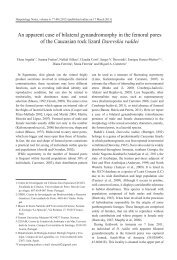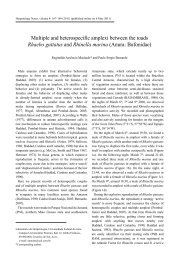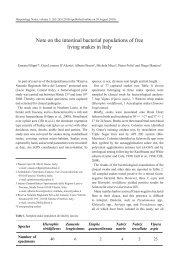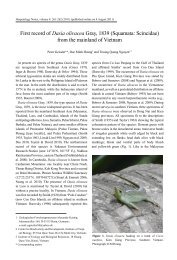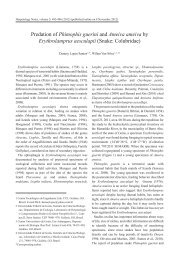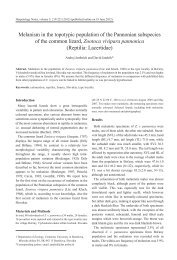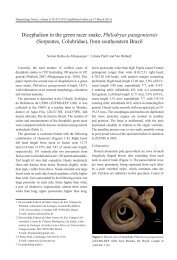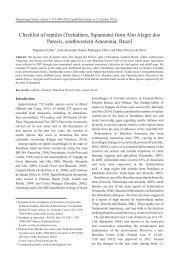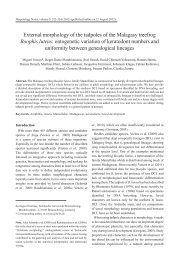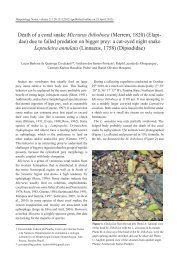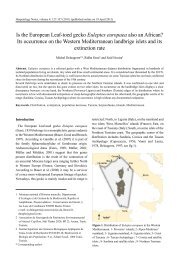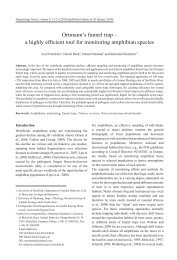The Leaf-toed gecko Euleptes europaea - Herpetology Notes
The Leaf-toed gecko Euleptes europaea - Herpetology Notes
The Leaf-toed gecko Euleptes europaea - Herpetology Notes
Create successful ePaper yourself
Turn your PDF publications into a flip-book with our unique Google optimized e-Paper software.
<strong>Herpetology</strong> <strong>Notes</strong>, volume 6: 571-575 (2013) (corrected version, published online on 8 December 2013)<strong>The</strong> <strong>Leaf</strong>-<strong>toed</strong> <strong>gecko</strong> <strong>Euleptes</strong> <strong>europaea</strong> (Squamata:Sphaerodactylidae) discovered on the Lérins Islands(Alpes-Maritimes, Southeastern France)Julien Renet 1* , Gabriel Martinerie 1 , Vincent Kulesza 2 and Florence Ménétrier 1<strong>The</strong> European <strong>Leaf</strong>-<strong>toed</strong> <strong>gecko</strong> <strong>Euleptes</strong> <strong>europaea</strong>(Gené, 1839) is endemic to the Western Mediterraneanand is listed in Annex II and IV of the European HabitatsDirective (92/43/CEE). This small-sized nocturnal <strong>gecko</strong>is a specialist of narrow rocky crevices (Delaugerre,2010) and is known to inhabit mostly islands in Provence(Southern France), Liguria (North-Western Italy), theTuscan archipelago (Central Italy), Sardinia (terratypica), the Corsica and Galite Archipelago (NorthernTunisia) (Delaugerre, 1997; Nougaret and Petenian,2003; Salvidio and Sindaco, 2006; Delaugerre, 2010;Delaugerre, Ouni and Nouira, 2011) (Fig.1). Howeverthe species is also found in mainland localities located inthe Alpes-Maritimes, east of Nice (Kulesza, Delaugerreand Cheylan, 1995; Renet et al. 2008, Renet et al. 2013),Liguria between Genoa and La Spezia and along 100km of coastline north of Monte Argentario in Tuscany(Salvidio, Lanza and Delaugerre, 2010) (Fig. 1).<strong>The</strong> existence of the Alpes-Maritimes mainlandpopulations suggests that island populations mightoccur in this area.Within the framework of Natura2000 (Baie et Capd’Antibes – Iles de Lérins / FR9301573), herpetologicalsurveys were conducted in 2011 on Lérins Islands,located between the Napoule Bay and Juan Gulf (Cityof Cannes). This calcareous archipelago (dolomiterocks from the Liassic) is composed of two main1*Conservatoire d’espaces Naturels de Provence Alpes-Côted’Azur,Pôle Biodiversité, Ecomusée de la Crau, Boulevardde Provence, F13310 Saint-Martin de Crau, France; e mail:julien.renet@cen-paca.org2Office National des Forêts, Bureau d’études des Alpes-Maritimes et du Var, F06205 Nice, Franceislands, Sainte-Marguerite (210ha) and Saint-Honorat(30ha), and their satellite islets, located on their easternsides: La Tradelière (1.6ha) and Saint-Féréol (1.4ha)(Lefebvre, 1957; Augier, 1978).Surveys were conducted in four night sessions byteams of two to six observers (see Table 1. for moredetail). Monitoring effort (minutes x observers) wasmeasured whether the species was detected or not.<strong>The</strong> leaf-<strong>toed</strong> <strong>gecko</strong> was not detected on the two largerislands (Sainte-Marguerite and Saint-Honorat) despiteallocating an important surveying effort on these Islands(2326 minutes, Table 1). This absence could be due toan extremely low population density or might resultfrom the loss of suitable rupicolous micro-habitats: aconsequence of semi-natural reforestation processesinitiated by reforestation campaigns in the 19 thcentury. Remnants of potential habitats are comprisedof buildings and sea shore cliffs, that are highlyoccupied by the Moorish Gecko Tarentola mauritanica(Linnaeus, 1758). <strong>The</strong> Turkish <strong>gecko</strong> Hemidactylusturcicus (Linnaeus, 1758), which has been found onlyon Sainte-Marguerite island, still has a very smalldistribution range at this site.However, on May the 10 th 2011, a population ofEuropean <strong>Leaf</strong>-<strong>toed</strong> <strong>gecko</strong> was discovered on Saint-Féréol Islet and evidence suggesting the presence ofthe species (faeces) was observed on La Tradelière Islet(Fig. 1 & 2). On September 12 th 2011 two adults wereobserved, confirming its presence on La TradelièreIsland (Table 1). Three other Vertebrate species wereobserved on these two islets: Common Wall lizardPodarcis muralis (Laurenti 1768), Black rat Rattusrattus (Linnaeus, 1758) and Yellow-legged Gull Larusmichahellis (Naumann, 1840).<strong>The</strong> populations on these islets benefit from verysuitable habitats (sunny rock piles with numerouscavities) that have been degraded by human activitieson the larger islands.
572Julien Renet et al.Figure 1. Distribution of <strong>Euleptes</strong> <strong>europaea</strong> in the Western Mediterranean: 1- Provence islands; Red dot- New localities ofinsular population (Lérins Archipelago); 2- Alpes-Maritimes mainland; 3- Ligurian mainland; 4- Ligurian islets; 5- Coast ofTuscany; 6- Tuscan Archipelago; 7- Corsica and satellite islets; 8- Sardinia and satellite islets; 9- Northern Tunisian islets (LaGalite Archipelago)According to the survey effort, our results suggest thatleaf-<strong>toed</strong> <strong>gecko</strong> densities are rather low, at least lowerthan those observed on similar-sized islets elsewhere(Corsican islets in particular) (Delaugerre and Cheylan,1992). This low population density could be attributedto strong predation by rats, considered by some authorsas the cause for the decline of many insular lizardpopulations (Whitaker, 1973; McCallum, 1986; Cooper,Hawlena and Pérez-Mellado, 2009; Traveset et al.2009). However, no direct evidence for such predationwas recorded in this study.During our observations surveys, all of the individualswe detected displayed behavior by hiding deep incavities. This behaviour greatly contrasts with theirusual easy detection on rocky habitats (Renet et al. 2008;Salvidio and Oneto, 2008). This secretive behaviourcould be interpreted as spatial avoidance in response tothe presence of rodents (Hoare et al. 2007).
<strong>The</strong> <strong>Leaf</strong>-<strong>toed</strong> <strong>gecko</strong> <strong>Euleptes</strong> <strong>europaea</strong> (Squamata: Sphaerodactylidae) 573Table 1. Summary of the prospecting effort for the occurrence of European <strong>Leaf</strong>-<strong>toed</strong> <strong>gecko</strong> <strong>Euleptes</strong> <strong>europaea</strong> on LérinsArchipelago.Island (I) orislet (i)I Sainte-MargueriteLocalityprospectedLanding stage/villageCoordinates(wgs84)43, 5225°07, 0406°DateProspectingeffort (byminute xobservers)Presence of<strong>Euleptes</strong><strong>europaea</strong>TarentolamauritanicaOther GeckosHemidactylusturcicus08/05 98 X Xi LaTradelièreI Saint-Honorati Saint-FéréolFort St 43, 5237°Marguerite 07, 0444°Cemetery 43, 5214°07, 0418°Privateproperty (southdry stone wall)43, 5116°07, 0509°First aid post 43, 5212°07, 0371°East Battery 43, 5174°07, 0701°Fortin de la 43, 5169°Convention 07, 0683°<strong>The</strong> islet 43, 5155°07, 0733°Chapelle Saint-Caprais andWest headlandFortifiedmonastery andLower drystone wallSurroundingwall of AbbeyLerins43, 5079°07, 0377°43, 5059°07, 0478°43, 5059°07, 0468°East headland 43, 5077°07, 0550°East blockhaus 43, 5069°07, 0538°Landing stage 1 43, 5092°07, 0471°Landing stage 2 43, 5093°07, 0438°<strong>The</strong> islet 43, 5062°07, 0578°08/05 124 X08/05 18 X08/05 4008/05 40 X10/05 48 X10/05 40 X10/05 354 X (2 faeces)12/09X (2 adults)11/05 6011/05 210 X11/05 210 X11/05 252 X11/05 3011/05 108 X11/05 16210/0512/09532 X (4 adults)X (2 adults, 8juveniles)<strong>The</strong> nocturnal activity pattern of rats may force <strong>gecko</strong>sto remain hidden in small cavities, affecting theirprobability of detection.This possible avoidance behaviour in this newlydiscovered populations, together with similarobservations on Port-Cros Island (Delaugerre pers.com.), suggests we must be cautious regarding theirconservation status.Further surveying of these new populations may allowus to characterize their population biology (demographicstructure, biometry, body condition, genetics, etc.) andcould lead to a better understanding of their interactionswith rats. <strong>The</strong>se characteristics are crucial for efficientlyassessing the conservation status of these populationsand implementing appropriate conservation strategies.
574Julien Renet et al.Figure 2. A) Adult European <strong>Leaf</strong>-<strong>toed</strong> <strong>gecko</strong> <strong>Euleptes</strong><strong>europaea</strong> hiding in a karstic cavity, Saint-Féréol islet, Alpes-Maritimes, France. Photo: Julien Renet.B) European <strong>Leaf</strong>-<strong>toed</strong> <strong>gecko</strong> <strong>Euleptes</strong> <strong>europaea</strong> faeces,La Tradelière islet, Alpes-Maritimes, France. Photo: JulienRenet.Acknowledgments. This field work was carried out with thetechnical support of the nautical squad of Antibes – Juan lesPins city. For their technical and field support, we speciallythank Elisée Valles (Office National des Forets), Matthieu Gilli(municipal counsel of Antibes – Juan les Pins city), Didier Laurent(Sea and sea-shore service manager of Antibes – Juan les Pinscity), Karen Joyaux (Natura2000), Sébastien Sant (CEN-PACA),Leslie Motta (CEN-PACA internship) and Maxime Morel (CEN-PACA internship). We would also like to thank AlexandreVillers (University of Turku), Michel Delaugerre (Conservatoiredu littoral), Dario Ottonello (University of Genoa), SebastianoSalvidio (University of Genoa), Laurent Tatin (CEN-PACA)and Stephen Larcombe (Edward Grey Institute) for relevantsuggestions and English revision.ReferencesAugier, H. (1978): Les îles de Lérins (Méditerranée, France).1- Description générale, historique, bilan des travauxscientifiques, prospective. Bull. Mus. Hist. Nat. 38: 9-63.Cooper, W.E., Hawlena, D., Pérez-Mellado, V. (2009): Islettameness: escape behavior and refuge use in populations of theBalearic lizard (Podarcis lilfordi) exposed to differing predationpressure. Canadian Journal of Zoology 87(10): 912-919.Delaugerre M., Cheylan M. (1992): Atlas de répartition des Batracienset Reptiles de Corse. Parc Naturel Régional de Corse,Ecole Pratique des Hautes Etudes, Pampelune. 128 pp.Delaugerre, M. (1997): Phyllodactylus europaeus In: Gasc, J.P.,Cabela, A., Crnobrnja-Isailovic, J., Dolmen, D., Grossenbacher,K., Haffner, P., Lescure, J., Martens, H., Martinez-Rica,J.P., Maurin, H., Oliveira, M.-E., Sofianidou, T., Veith, M.,Zuiderwijk, A. (eds.): Atlas of Amphibians and Reptiles inEurope. Societas Europea Herpetologica and Muséum nationald’Histoire naturelle (IEGB/SPN), Paris. 496 pp.Delaugerre, M. (2010): Le Phyllodactyle d’Europe <strong>Euleptes</strong><strong>europaea</strong> In: Vacher, J.P., Geniez, M. (eds): Les Reptiles deFrance, Belgique, Luxembourg et Suisse. Biotope, Mèze(collection Parthénope), Muséum d’Histoire naturelle, Paris.544 pp.Delaugerre, M., Ouni, R., Nouira, S. (2011): Is the European <strong>Leaf</strong><strong>toed</strong>Gecko <strong>Euleptes</strong> Europaea Also an African? Its Occurrenceon the Western Mediterranean Landbrige Islets and Its ExtinctionRate. <strong>Herpetology</strong> <strong>Notes</strong> 4: 127–137.Hoare, M.J., Pledger, S., Nelson, N.J., Daugherty, C.H. (2007):Avoiding aliens: Behavioural plasticity in habitat use enableslarge, nocturnal <strong>gecko</strong>s to survive Pacific rat invasions.Biological Conservation 136(4): 510-519.Kulesza, V., Delaugerre, M., Cheylan, M. (1995): Le Phyllodactyled’Europe Phyllodactylus europaeus Gené 1839: Découverted’une population continentale en Provence. Faune de Provence16: 113-115.Lefebvre, R. (1957): <strong>Notes</strong> forestières et botaniques sur I’IleSainte-Marguerite. ENEF, Ecole nationale des eaux et forêts,Nancy (FRA). 417-457.McCallum, J. (1986): Evidence of predation by kiore upon lizardsfrom Mokohinau islands. New Zealand Journal of Ecology 9:83-87.Nougaret, R., Petenian, F. (2003): Contribution à l’étude duPhyllodactyle d’Europe <strong>Euleptes</strong> <strong>europaea</strong> Gené, 1839 (Reptilia,Sauria, Gekkonidae) sur l’archipel de Riou (Iles de Marseille,Bouches-du-Rhône). Faune de Provence 21: 5-11.Renet, J., Gerriet, O., Jardin, M., Magne D. (2008): Les populationsde Phyllodactyle d’Europe <strong>Euleptes</strong> <strong>europaea</strong> Gené, 1839Reptilia, Sauria, Gekkonidae dans les Alpes-Maritimes:premiers éléments sur leur répartition et leur écologie. Faune deProvence 24/25: 117-126.Renet, J., Gerriet, O., Kulesza, V., Delaugerre, M. (2013):Le Phyllodactyle d’Europe <strong>Euleptes</strong> <strong>europaea</strong> (Gené,1839) (Reptilia, Squamata, Sphaerodactylidae) - Lespopulations continentales françaises ont-elles un avenir ? Bull.Soc. Herp. Fr. 145/146: 189-198.Salvidio, S., Sindaco, R. (2006): <strong>Euleptes</strong> <strong>europaea</strong> In Sindaco R.,Doria, G., Razzetti E., Bernini F (Eds). Atlante degli Anfibi edei Rettili d’Italia : Atlas of Italian Amphibians and Reptiles,Societas Herpetologica Italica, Ed. Polistampa, Firenze, pp.414-417.Salvidio, S., Oneto, F. (2008): Density regulation in theMediterranean leaf-<strong>toed</strong> <strong>gecko</strong> <strong>Euleptes</strong> <strong>europaea</strong>. EcologicalResearch 23: 1051-1055.
<strong>The</strong> <strong>Leaf</strong>-<strong>toed</strong> <strong>gecko</strong> <strong>Euleptes</strong> <strong>europaea</strong> (Squamata: Sphaerodactylidae) 575Salvidio, S., Lanza, B., Delaugerre, M. (2010): <strong>Euleptes</strong> <strong>europaea</strong>(Gené, 1839). In Corti C., Capula M., Luiselli L., Razzetti E.,Sindaco R. (eds): Fauna d’Italia, Reptilia. Edizioni Calderini deIl Sole 24 ORE Editoria Specializzata S.r.l., Bologna.Traveset, A., Nogales, M., Alcover, J.A., Delgado, J.D., Lopez-Darias, M., Godoy, D., Igual, J.M., Bover, P. (2009): Areview on the effects of alien rodents in the Balearic (WesternMediterranean Sea) and Canary Islands (Eastern AtlanticOcean). Biological Invasions 11(7): 1653-1670.Whitaker, A.H. (1973): Lizard populations on islands with andwithout Polynesian rats, Rattus exulans (Peale). Proceedings ofthe New Zealand Ecological Society 20: 121-130.Accepted by Mirco Solé



